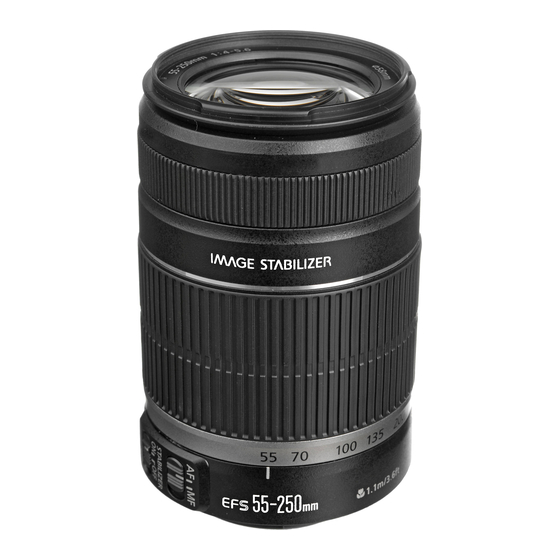Canon 5123B006 사용 설명서 - 페이지 3
{카테고리_이름} Canon 5123B006에 대한 사용 설명서을 온라인으로 검색하거나 PDF를 다운로드하세요. Canon 5123B006 12 페이지. Image stabilizer

Safety Precautions
• Do not look at the sun or a bright light source
through the lens or camera. Doing so could result
in loss of vision. Looking at the sun directly through
the lens is especially hazardous.
• Whether it is attached to the camera or not, do
not leave the lens under the sun without the
lens cap attached. This is to prevent the lens from
concentrating the sun's rays, which could cause a
fire.
Handling Cautions
• If the lens is taken from a cold environment into
a warm one, condensation may develop on the
lens surface and internal parts. To prevent
condensation in this case, first put the lens into an
airtight plastic bag before taking it from a cold to
warm environment. Then take out the lens after it
has warmed gradually. Do the same when taking
the lens from a warm environment into a cold one.
• Do not leave the lens in excessive heat such as in
a car in direct sunlight. High temperatures can
cause the lens to malfunction.
This device complies with Part 15 of the FCC Rules. Operation is
subject to the following two conditions: (1) This device may not
cause harmful interference, and (2) this device must accept any
interference received, including interference that may cause
undesired operation.
Do not make any changes or modifications to the equipment
unless otherwise specified in the instructions. If such changes or
modifications should be made, you could be required to stop
operation of the equipment.
This equipment has been tested and found to comply with the
limits for a class B digital device, pursuant to part 15 of the FCC
Rules. These limits are designed to provide reasonable protection
against harmful interference in a residential installation. This
equipment generates, uses and can radiate radio frequency
energy and, if not installed and used in accordance with the
instructions, may cause harmful interference to radio
communications.
However, there is no guarantee that interference will not occur in
a particular installation. If this equipment does cause harmful
interference to radio or television reception, which can be
determined by turning the equipment off and on, the user is
encouraged to try to correct the interference by one or more of
the following measures:
• Reorient or relocate the receiving antenna.
• I ncrease the separation between the equipment and receiver.
• C onnect the equipment into an outlet on a circuit different from
that to which the receiver is connected.
• C onsult the dealer or an experienced radio/TV technician for
help.
CAN ICES-3 (B) / NMB-3 (B)
ENG-2
